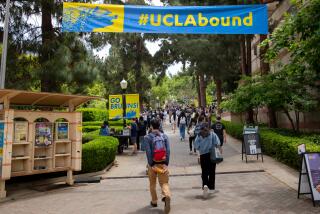The Dog Ate My Zip Disk (Really)
- Share via
Living: Double-occupancy rooms prevail, but new construction on some campuses brings more single units. Rooms offer better acoustic privacy and climate control. Layouts are more flexible, with movable beds and wardrobes.
Communal bathrooms? Passe. Cost of room and board, according to school projections: about $7,500.
* High-speed--not dial-up--connections to the 2010 incarnation of multimedia-enabled data networks such as the Internet. This means “one port per pillow” in the wall or a satellite-based wireless link or an all-in-one flat-panel wall monitor that delivers interactive Internet and TV service. Or all of the above.
** Common areas are customized to serve students clustered in dorms by major or communities of interest. In-dorm computer labs contain equipment optimized for specific tasks such as hard-core number crunching or structural modeling. Faculty offices and apartments crop up within residence halls in another move toward increased academic support.
*
Learning: Flexible curriculum and course requirements accommodate tech-savvy students with short attention spans or entrepreneurial sidelines. Armed with new tools, students work more autonomously, accessing a lecture, text or video at any time, in any location. Online dialogue and videoconferencing are integral to academic life. “Just-in-time” learning, a concept borrowed from forward-thinking firms that value flexibility and abhor inventory, means less time parked in a lecture hall and more time for hands-on creating and exploring, a boon to a society with complex problems to solve. Cost of tuition and fees, according to school estimates: about $4,000 (UCLA); about $20,000 (USC); about $23,000 (Stanford).
**Syllabuses encompass far-flung lectures and conferences. Required “reading”--books, articles, experiments, performances--is accessed through a data network or stored on a memory card that plugs into the information appliance.
*
Right Brain: Specialties spring up to address the political and cultural impact of the burgeoning senior-citizen set. Mark Twain and other traditional writers gain stature as historical touchstones in a smaller, faster world. Courses in Japan’s underground culture and black utopian science fiction become electives. Studies of “difference”--ethnic, gender, sexual orientation, social class--regain momentum. In communications, the emphasis shifts from writing to “authoring”--creating not just text, but multimedia content.
*
The Device: A 2-pound portable computing/communications appliance all but supplants books. It accesses course materials from the network and facilitates note-taking, composing papers, designing graphics, e-mail and electronic commerce. As chips and software soar in power, and bandwidth becomes a low-cost commodity, the machine produces crisp real-time video and audio. It plays back lectures in any voice--be it the instructor’s, the student’s, even Barry White’s--or in a second language. The keyboard won’t be the only input method. It competes with touch screens, a stylus or perhaps a cursor that moves with the eyes.
*
Left Brain: Computer science departments offer quantum computing, which seeks to push the physics-imposed limits on silicon-based electronics (that is, if silicon is still the standard microelectronics medium). With the human genome decoded, biotechnology and genetic engineering focus on longevity and disease prevention. In tandem, bioethics booms. Space studies mirror a growing human presence in the final frontier.
*
id: All-purpose student ID unlocks residence hall entrances and dorm rooms and functions as a debit card at campus dining halls, stores and laundry facilities. It features a bar code for checking out library materials. Higher-security areas of campus may employ biometric identification systems that recognize fingerprints, voice, facial features or the iris.
alarm: With the push of a button, a “personal alarm” sends an emergency alert to a network monitored by campus security.
*
Brain Food: “Cognitive enhancers,” the fruit of research into Alzheimer’s disease, can be contained in snacks to increase alertness and mental performance. Natural alternatives include lecithin derivatives, such as phosphatidyl choline, a key to production of the neurotransmitter acetylcholine. Though one natural supplement already on the market, Brain Gum, promises to “switch on the brain,” coffee remains the stimulant of choice.
*
Recreational Drugs: Psychedelics, but refined. You take the trip but leave the baggage--anxiety and mental impairment--behind.
*
Researched by Edward Silver


